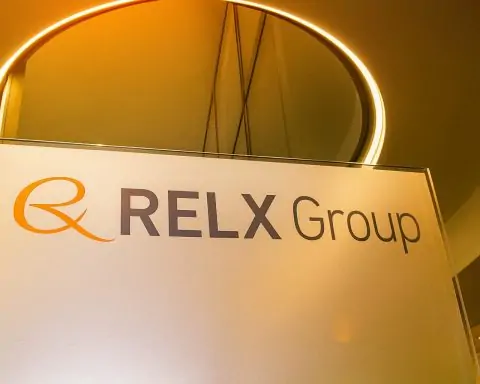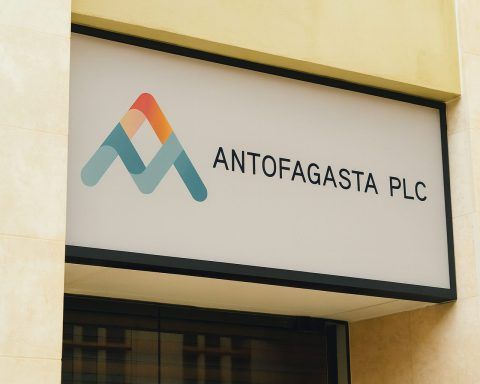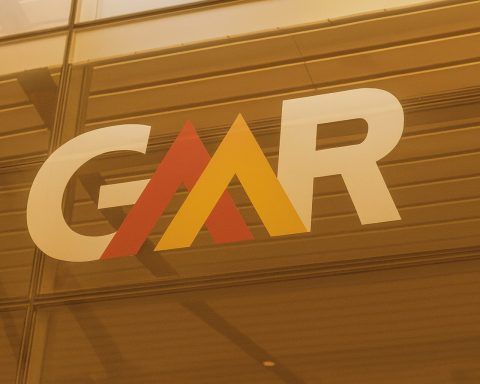- Stock Price & Performance: NVTS closed around $8.87 on October 10, 2025 after hitting a new 52-week high of $9.79 intraday [1]. The stock has surged roughly +149% year-to-date (and about +275% over the past 12 months) [2], vastly outperforming the broader semiconductor industry. Over the last five sessions, NVTS gained about 11–14% (roughly double-digit weekly rise), reflecting strong recent momentum.
- Market Cap & Valuation: Navitas’s market capitalization is approximately $1.9 billion as of Oct 10 [3]. The stock trades at a rich valuation – about 26–28× forward sales, far above the industry average (~9.5×) [4]. It has no P/E ratio due to negative earnings, and its price-to-book is near 4.9 [5]. NVTS sits well above key moving averages (50-day ~$6.66, 200-day ~$5.25 [6]), underscoring a strong uptrend, though its RSI ~71 indicates near-overbought conditions [7].
- Recent Catalysts: The stock’s 2025 rally has been fueled by Navitas’s strategic shift toward AI data centers and high-growth markets. In mid-2025, Navitas announced a partnership with NVIDIA to co-develop next-gen 800V high-voltage DC power architecture for AI data centers [8]. The company is also transitioning its manufacturing to 8-inch GaN wafers (from 6-inch) through a new foundry partner (Powerchip), aiming to cut costs and boost capacity [9]. Additionally, Navitas raised $100 million in new capital (issuing ~20M shares) to fund growth and pivot away from lower-margin consumer products [10].
- Leadership & Governance: In a significant leadership move, Navitas appointed Chris Allexandre as CEOeffective September 1, 2025 [11]. Allexandre is a semiconductor veteran (ex-Renesas executive) with a track record in power electronics and cloud/automotive markets, brought on to drive Navitas’s next growth phase in AI data centers and energy infrastructure [12] [13]. Co-founder Gene Sheridan stepped down as CEO after 11 years, having led Navitas from startup through its SPAC IPO in 2021.
- Upcoming Events: Navitas will report its Q3 2025 earnings on November 3, 2025 (after market close) [14]. Analysts and investors will watch for updates on the AI data center initiatives, revenue trajectory, and any guidance amid the company’s ongoing market transition. The last reported quarter (Q2’25) saw revenue decline ~29% YoY to $14.5M [15], so the Q3 results and outlook will be pivotal for sustaining the stock’s momentum.
Company Background and Business Model
Navitas Semiconductor is a fabless semiconductor company founded in 2014 that specializes in next-generation power electronics. It pioneered the integration of gallium nitride (GaN) transistors with drive, control, sensing, and protection circuits into single “GaNFast” power ICs [16]. These GaN power chips switch much faster than traditional silicon, enabling smaller, more efficient chargers and power converters. Navitas’s technology can increase energy efficiency by up to 40% and switch speeds 100× faster than legacy silicon solutions [17], allowing power systems to be significantly lighter and more compact.
The company initially gained traction in consumer electronics – its GaN ICs have been used in ultra-fast smartphone and laptop chargers (for example, Xiaomi’s latest 90W GaN charger is built on Navitas GaNSense chips) [18] [19]. By monolithically integrating the GaN power FET and control circuitry, Navitas made it easier for manufacturers to adopt GaN, delivering “digital in, power out” simplicity for power designers [20]. This helped Navitas build a leading position in the fast-charger market over the past five years.
Navitas operates a fabless model, outsourcing production of its GaN devices to foundries. (It has used TSMC for 6-inch GaN wafers and is now partnering with Powerchip Semiconductor (PSMC) to move to 8-inch wafers [21].) This outsourcing strategy allows Navitas to scale production without owning fabs, though it must carefully manage supply partners. In 2022, Navitas also acquired GeneSiC, a Silicon Carbide (SiC) device company, expanding its portfolio to include high-voltage SiC diodes and MOSFETs. With both GaN and SiC, Navitas now targets a broad range of applications – from mobile chargers and consumer electronics to solar inverters, electric vehicles, industrial motors, and data centers [22].
Navitas went public via SPAC merger in late 2021 (valued around $1.04B enterprise value at the time) [23]. The stock initially struggled post-IPO (falling well below its $10 SPAC price amid 2022’s tech sell-off – at one point under $2 in early 2024), but 2025 has marked a dramatic turnaround. The company styles itself as the “only pure-play next-gen power semiconductor” firm, focused exclusively on GaN and SiC technologies [24] [25]. This pure-play status means Navitas is a direct bet on the wider adoption of GaN/SiC in the coming electrification wave. Its mission statement is literally to “Electrify Our World™” by replacing legacy silicon chips with faster, greener GaN and SiC across all high-power markets [26] [27].
Recent Developments and News (October 2025)
AI Data Center Partnership with NVIDIA
The defining storyline for Navitas in 2025 is its entry into the AI data center arena via NVIDIA’s ecosystem. In mid-2025, Navitas announced a collaboration with NVIDIA to develop an 800-volt high-voltage direct current (800V HVDC) power architecture for next-generation AI server farms [28]. NVIDIA’s plan to transition data centers from traditional 54V DC to 800V DC by 2027 is a game-changer in power design, and Navitas was named as a partner to provide critical GaN/SiC-based power solutions.
This Nvidia endorsement jolted investor optimism – Navitas’ stock “shot into orbit” after the news, rising over 100% in the first half of 2025 [29]. It has changed the narrative around NVTS from a niche charger play into a potential “arms dealer” of the AI revolution, alongside much larger chip firms. Navitas’s GaN and SiC technology can cover the entire power conversion chain in an 800V data center: from the front-end 13.8kV AC conversion to 800V DC, down to the rack-level 48V converters that feed GPUs [30]. If Nvidia’s vision materializes, there will be a wave of new power electronics demand – and Navitas is positioning to grab its share of that huge market. The company estimates a $2.6 billion annual market for GaN/SiC in AI data centers by 2030 [31]. However, this opportunity is on the horizon: data center vendors will finalize supplier selections by 2026, with volume deployments in 2027 [32], meaning Navitas still has to win designs and wait years for meaningful revenue.
In the meantime, the Nvidia partnership has provided immediate credibility. “With rising demand from AI data centers and accelerating EV adoption, Navitas may be one of the most important growth stories of the decade,” one bullish analyst declared [33]. The mere association with Nvidia – often called the “AI superpower” of chips – has put Navitas on the radar of growth investors. In September alone, NVTS jumped 23%, bringing it to ~126% YTD gain by early October [34]. This surge came despite Navitas still having never generated an annual operating profit [35]. Clearly, the market is pricing Navitas on future potential in AI and energy, rather than current earnings.
Shift to 8-Inch GaN Wafers (Powerchip Deal)
Another recent development is Navitas’s move to 8-inch GaN manufacturing, aimed at slashing production costs and improving scale. On October 10, a report highlighted Navitas’s partnership with Powerchip Semiconductor (a Taiwanese foundry) to migrate from 6-inch to 8-inch GaN wafer fabrication [36]. The larger wafers yield ~80% more chips per batch with only marginally higher cost, which can dramatically improve unit economics [37]. According to Zacks analysts, this transition is part of Navitas’s plan to boost margins and return to a growth trajectory after a tough year [38].
Navitas will have TSMC continue supplying 6-inch GaN wafers through at least mid-2027 as a bridge [39], while Powerchip ramps the new 8-inch lines. Over the next two years, most of Navitas’s high-voltage GaN customers are expected to qualify and move to the 8-inch process [40]. Crucially, this goes hand-in-hand with Navitas refocusing on higher-value markets – the company is consciously “cutting back on lower-margin mobile and consumer products” (like commodity phone chargers) to redirect resources to AI data center and energy infrastructure applications [41]. Management sees those segments as offering higher performance and better margins, aligning with the 8-inch GaN capability coming online. If executed well, the 8-inch shift “can support Navitas’s long-term goal of stronger margins and steady growth” [42]. (Notably, Q2 2025 revenue was down 29% YoY [43], reflecting that prior mobile-centric growth had stalled; the 8-inch strategy is an attempt to reignite growth via new markets).
Leadership Change and Strategic Refocus
At the end of August 2025, Navitas announced that CEO Gene Sheridan would step down, with Chris Allexandre appointed as the new President and Chief Executive Officer (effective Sept 1) [44]. Allexandre’s hiring is strategically timed: “Chris is joining Navitas at a pivotal moment in its evolution,” said Board Chairman Richard Hendrix, citing Allexandre’s experience in driving transformation and growth in power semiconductor businesses [45]. Indeed, Allexandre comes from Renesas where he led a $2.5B power division and oversaw the acquisition of Transphorm (a GaN company) in 2024 [46]. He has deep expertise in sales and operations in cloud, industrial and automotive markets – exactly where Navitas wants to expand.
This leadership transition underscores Navitas’s “all-in” pivot to higher-power markets. Sheridan (the co-founder) expressed pride in creating “the industry’s only next-gen, pure-play power semi company” and agreed it was the right time to hand over the reins for the next chapter [47]. With Allexandre at the helm, Navitas is explicitly positioned to chase AI data center, EV, and energy infrastructure opportunities using its GaN and SiC portfolio [48] [49]. Investors often welcome such seasoned leadership in a growth-stage tech firm – Allexandre’s operational discipline could help Navitas eventually scale revenues and, importantly, move toward profitability in the coming years. The market reacted positively to the CEO news, as it reinforced the narrative that Navitas is gearing up for “prime time” in big markets.
Other Notable News
- Financial Updates: Navitas’s Q2 2025 earnings (reported Aug 4) showed revenue of $14.5M (down ~29% YoY) with a GAAP operating loss of $21.7M [50] [51]. In light of weakness in the mobile charger segment, management lowered Q3 revenue guidance to ~$10M (a further sequential drop) and cited near-term headwinds like China tariffs and a more selective approach to consumer markets [52] [53]. The company simultaneously announced the $100M equity raise and the Nvidia & Powerchip partnerships as part of a strategic pivot [54] [55]. Navitas characterized this pivot as “necessary but painful” – sacrificing mature low-growth business in the short term to invest in the high-growth AI/data center future [56]. Investors largely looked past the weak current results, focusing on the long-term story (as evidenced by the stock continuing to rally). The upcoming Q3 report on Nov 3 will be closely watched to see if the revenue trough is near and for any initial traction in new verticals.
- Product/Customer Wins: Navitas continues to secure design-wins in its legacy markets, which remain an important base of business. For example, in late July Navitas announced that Xiaomi’s new flagship 90W phone charger is built with Navitas’s GaNSense™ chips, achieving a record-small form factor with high efficiency [57] [58]. This showcases that Navitas’s GaN technology is still at the cutting-edge of consumer fast charging, setting “new standards for performance, size, and weight” in portable chargers [59] [60]. Such wins reinforce Navitas’s leadership in GaN mobile chargers and provide ongoing revenue (even as that segment has slowed compared to the pandemic-era fast charger boom). Navitas has indicated it will maintain a presence in mobile/consumer markets, but with greater selectivity – prioritizing profitable projects and leveraging its integrated GaN IC advantage, while channeling more R&D toward the bigger AI, automotive, and industrial opportunities.
- Stock Surge and 52-Week High: By early October, NVTS shares broke out to new highs. On October 10, the stock spiked to $9.79, a fresh 52-week high, on extremely heavy volume (~46 million shares traded) [61] [62]. It ultimately closed up about 11–12% on the day around $8.87 [63]. This jump came as traders piled in following the company’s positive exposure in an Oct 10 analyst piece about the 8-inch GaN transition (and possibly anticipation of the Nov 3 earnings). MarketBeat noted the milestone, highlighting that Navitas “reached a new 52-week high” and discussing recent analyst actions [64]. Notably, NVTS has now gained over 230% in the past year [65]. Such a rapid ascent attracted both momentum investors and some profit-taking – the stock is volatile, with a beta ~3.0 indicating triple the market volatility [66]. (In fact, NVTS’s short interest is relatively high at ~28% of float [67], suggesting a group of skeptics or hedge funds betting on a pullback. Some of the spikes in recent weeks may partly reflect a short squeeze as shorts rush to cover when the stock powers higher.)
Competitor and Sector Overview
Navitas is operating in a highly competitive landscape, going up against both startups and industry giants in power semiconductors. In the emerging GaN power IC niche, Navitas’s peers include companies like Transphorm (now part of Renesas), EPC (Efficient Power Conversion), and GaN Systems (acquired by Infineon in 2023). However, as Navitas expands into high-power markets (data centers, EV, solar), it increasingly faces competition from the established SiC and power semiconductor leaders:
- Wolfspeed (WOLF): Wolfspeed (formerly Cree) is a pure-play SiC semiconductor leader and a key supplier of high-voltage devices for EVs and infrastructure. It is aggressively investing – e.g. building a $3 billion Mohawk Valley SiC fab – to meet soaring demand [68]. Wolfspeed’s SiC technology is a direct alternative to GaN in many high-power applications. For AI data center power, Wolfspeed’s SiC solutions (like high-voltage MOSFETs for 13.8kV to 800V conversion) could compete with Navitas’s GaN/SiC hybrid approach. Navitas will have to prove that GaN (perhaps used in combination with SiC) can offer efficiency or cost advantages in those systems.
- ON Semiconductor (ON): ON Semi has emerged as a strong player in both SiC and power modules. It is expanding its SiC portfolio and explicitly targeting cloud and AI data center customers with 800V power modules [69]. Tellingly, ON announced it has partnered with NVIDIA as well to advance 800V DC power for next-gen data centers [70]. This means Navitas and ON could be vying for similar sockets in Nvidia’s reference designs. ON brings the heft of a $40B company with broad manufacturing and R&D resources – a formidable competitor. Navitas will bank on its focus and GaN IP to carve out a niche, but ON’s Nvidia partnership shows the competition for this market will be intense.
- Infineon Technologies and STMicroelectronics: These are two European semiconductor giants that have also been named as partners by Nvidia for its 800V data center initiative [71]. Infineon acquired GaN Systems and has its own SiC line; STMicro is a leader in SiC and is investing in GaN as well. Both companies have deep relationships in automotive and industrial power – sectors Navitas covets. The Motley Fool notes Navitas is “up against some powerful competition, such as Infineon and STMicro… however, Navitas is a pure-play GaN/SiC company, and any significant revenue from 800V data centers will move the needle for it” [72]. In other words, while Infineon or ST are much larger, success in this new niche would be material for Navitas in a way it might not be for the conglomerates (giving Navitas potentially more incentive to innovate quickly here).
- Other Players: In EV and renewable energy, Navitas will also encounter competitors like Texas Instruments (analog power ICs), Power Integrations (which has started offering GaN-based ICs for chargers), and Gan Systems/Transphorm (via their new parent companies). Even startups in the GaN space (e.g. Navier, NexGenetc.) could challenge on specific applications. Furthermore, silicon power devices are not standing still – improved silicon MOSFETs or new architectures (like vertical GaN or advanced topologies) could prolong the life of silicon in some areas, delaying GaN adoption. Essentially, Navitas must compete on technology performance and cost to displace incumbents. The good news is that the overall power semiconductor market is growing with the electrification trend, so multiple winners can co-exist if the pie expands. But Navitas, as a smaller firm, is racing to establish itself in high-volume markets before the giants fully muscle in.
It’s worth noting that Navitas’s strategy is also to partner within the ecosystem. For example, it collaborates with power system companies and OEMs to integrate its chips into reference designs (recently partnering with a major data center power supply firm Vertiv, according to some reports). This ecosystem play is important because end-customers (like cloud providers or car makers) often prefer validated solutions. Navitas’s advantage is that as a pure-play it can partner broadly (whereas, say, Infineon might push its own total solution). But the flip side is Navitas lacks the breadth of product portfolio that big competitors can bundle. Overall, Navitas is navigating a “coopetition” environment – sometimes collaborating (as with Nvidia) while also indirectly competing with fellow Nvidia partners like ON and Infineon. The next 1-2 years will be critical for Navitas to prove its GaN/SiC tech in real-world, large-scale projects to secure a lasting foothold.
Financial & Technical Analysis
Revenue/Earnings Profile and Outlook
Navitas is not yet profitable and has been operating at a loss as it invests in growth. In fiscal 2024, Navitas’s revenue was about $83 million [73], and for 2025 the Zacks consensus forecast is ~$54M, a 35% YoY decline in revenue [74]. This drop reflects the saturation and slowdown in the mobile charger market (which had driven earlier growth) and a transitional year as Navitas pivots to new areas. Indeed, through the first half of 2025, revenues were down ~30% YoY and Q3 is guided to fall further [75] [76]. The company expects 2026 to resume growth (+23% rev forecast) [77], as AI/data center programs start contributing and as general demand for GaN/SiC picks up. But for now, Navitas is in a trough. On the bottom line, Navitas remains in the red; analysts estimate a net loss of about $0.51 per share for full-year 2025 [78]. That would be roughly a $-0.22 EPS (non-GAAP) if excluding certain items, slightly better than the prior year’s -$0.24 [79]. For 2026, the consensus is a ~$0.19 loss, i.e. only modest improvement [80]. In short, no break-even is expected until perhaps 2027 or beyond, which is when the big AI data center ramp might happen.
Navitas’s gross margins are relatively low for a fabless chip company (Q2 2025 non-GAAP gross margin was ~39%, and Q3 guidance is similar [81]). This is partly because in the consumer charger market, pricing eroded as multiple GaN vendors competed. Navitas hopes the move to 8-inch wafers and focus on enterprise markets will lift margins over time. Operating expenses are high as a percentage of sales (given the heavy R&D investment and still small revenue base), leading to sizeable operating losses (-$21.7M GAAP op loss in Q2) [82]. The company’s balance sheet was bolstered by the $100M equity raise, and it carries minimal debt, so liquidity is not an immediate concern. The key financially is whether Navitas can scale revenues significantly in 2026-2028 to achieve economies of scale – if it can tap even a fraction of the $2.6B AI/data center TAM, the revenue could multiply, dramatically improving the earnings picture. But until then, investors are essentially funding a growth story with the understanding that near-term financials are weak.
Valuation Metrics
After its steep rally, NVTS stock commands a premium valuation on most metrics. The stock’s forward Price-to-Sales (P/S) ratio is around 26–27×, versus the semiconductor industry average of ~9.5× [83]. Even looking out to 2026 projected sales, the P/S would be in the high teens – indicating a lot of growth is already “priced in.” Traditional P/E is not meaningful due to negative earnings (the trailing P/E is -14 if one calculates, since EPS is negative [84]). Price-to-book is about 4.8× (with ~$1.82 book value per share) [85]. For a sense of scale, Navitas’s ~$1.9B market cap implies it’s valued at ~22× 2024 sales (and much higher multiple of current gross profit). This valuation can only be justified by future earnings potential – investors are valuing Navitas as a high-growth tech disruptor. By comparison, larger analog/power semiconductor peers (like ON or Infineon) trade at more moderate multiples and are profitable. This dichotomy underscores that NVTS is valued more like an early-stage growth stock than a mature chip company.
One should note that Navitas’s stock price is extremely sensitive to news and sentiment. Its beta is around 3.0, meaning it’s three times more volatile than the market [86]. Small changes in narrative (e.g. an analyst report or a partnership announcement) can swing the stock significantly. Furthermore, the high short interest (~28% of float) suggests many traders are actively betting on valuation coming down to earth [87]. Any hiccup in execution (or a broader tech sell-off) could trigger a sharp drop as those longs who bought into the story might rush to the exits. In a way, Navitas’s valuation is a double-edged sword: it gives the company a strong currency for fundraising or acquisitions (indeed, it raised capital at high prices), but it also means the stock may have limited upside in the near term unless fundamentals dramatically surprise to the upside.
Analyst Sentiment and Price Targets
Wall Street analysts are mixed on NVTS, reflecting the tug-of-war between the long-term promise and short-term challenges. According to MarketBeat data, the stock has an average rating of “Hold” with 3 Buy, 3 Hold, and 2 Sellrecommendations [88]. The consensus price target is about $5.65 per share [89], significantly below the current trading range – implying analysts broadly think the stock is overvalued after its huge run. For instance, Craig Hallum downgraded Navitas from Buy to Hold in August and set a $6.00 target [90]. Deutsche Bankhad downgraded it earlier (June) to Hold with an even more bearish $3.50 target [91]. Morgan Stanley in August maintained an Underweight stance with a $4.40 target [92]. These firms essentially see Navitas as ahead of its fundamentals, given the revenue declines and years of losses ahead. On the bullish side, Rosenblatt Securities has remained positive with a Buy rating, though even their price target was $8.00 [93] (which NVTS now exceeds). The highest target among notable firms was from Jefferies back in 2021 ($16), but they later cut it to $4 in 2024 [94] – underscoring how sentiment flipped when the stock crashed last year, and now perhaps has swung overly optimistic again.
In qualitative terms, sentiment is split. Some analysts caution that Navitas is “overhyped…coasting on Nvidia partnership hopes” while suffering “declining revenues and ongoing losses” [95]. This was the view of a recent Seeking Alpha piece that argued the Nvidia news, while encouraging, doesn’t justify the magnitude of the stock’s rise given the lack of current earnings. On the other hand, growth-focused commentators (e.g. Motley Fool contributors) highlight the transformative potential: Navitas has “groundbreaking GaNFast technology” and could ride the AI and EV boom to far higher sales, which is why they believe the stock “could soar another 50% by 2026” [96]. The Motley Fool in October pointed out NVTS had already gained 230% in the past year, yet suggested this “could be just the beginning” of its story if its end-markets play out as hoped [97]. This bullish camp essentially argues that Navitas’s current valuation will look cheap if Navitas becomes a critical supplier in a multi-billion-dollar AI power market (the if, of course, is the crux).
For an individual investor, it’s important to recognize that analyst targets for NVTS are all over the map – from as low as $1.50 (Morgan Stanley’s very bearish case earlier) [98] to around $9–10 on the optimistic side historically. The wide dispersion reflects high uncertainty. The consensus ~$6 target suggests ~30% downside, which typically would be a red flag; however, fast-moving small-cap stocks often trade past analyst targets in momentum phases. Investors should watch for any revisions in targets or ratings after Q3 earnings or major news – upgrades could fuel further rallies, while any disappointments could prompt downgrades or cautious commentary that weigh on the stock.
Technical Analysis
From a technical standpoint, NVTS has been in a strong uptrend throughout 2025. The stock’s 50-day moving average (MA) is around $6.66 and the 200-day MA near $5.25 [99], both far below the current price – a technically bullish condition (the stock is trading well above both its intermediate and long-term trend lines). In fact, NVTS hasn’t touched its 50-day MA since August, as each dip has been met with new buying interest. The slope of the 200-day turned decisively upward in recent months as the stock more than quadrupled off its spring lows. This kind of price action and moving average alignment often signals positive momentum; traders would say Navitas is in an “uptrend channel.”
However, the meteoric rise also brings some caution signs. The Relative Strength Index (RSI) is hovering around 70 [100], which is generally the threshold of overbought territory. An RSI above 70 can indicate the stock might be due for a breather or pullback in the near term. We saw brief pullbacks in early September and again in early October, but each time NVTS found support after roughly 20–25% corrections, before roaring to new highs on volume. Speaking of volume, trading activity has spiked dramatically on big news days – e.g., volume was over 72 million shares on Oct 10when it hit the new high [101] (versus an average volume ~26 million [102]). Such volume spikes on up-days are typically a bullish sign (indicating heavy accumulation). MarketBeat noted the Oct 10 rally came on unusually high volume and marked a breakout from the prior range [103] [104].
A few key technical levels to watch: On the upside, if NVTS can break above $9.79 (the intraday high), it could enter a new range – there may be psychological resistance around the $10 mark (also a round-number and former SPAC price). Beyond that, there isn’t much historical resistance since the stock would be at all-time highs (its all-time high shortly after the 2021 listing was around $20, but that was before a big drawdown). On the downside, support might come in around $7.50–$8.00 (recent consolidation zone and roughly the point of the October breakout). Further support levels would be the 50-day MA ~$6.66, and below that around $5 (which was a level the stock based around during the summer rally). Volatility is high – NVTS’s daily swings of 8-10% have not been uncommon – so risk management is important for anyone trading this stock. If broader tech sentiment sours or if Navitas’s news flow slows, a retracement to the mid-single digits isn’t out of the question given how far and fast it ran. Conversely, continued bullish momentum (and any positive surprises) could see the stock sustain above $10. Technical analysts might also note that NVTS’s 20-day MA is steeply upward (the stock is ~23% above its 20-day currently) [105], so even a “normal” pullback to that short-term mean would mean a 20% drop – again emphasizing the volatility. In summary, technically NVTS is strong but stretched, riding a wave of momentum that could continue, but with very little room for error.
Forward-Looking Perspective: Opportunities and Risks
Navitas sits at the crossroads of major tech megatrends – the electrification of everything (from vehicles to data centers) and the shift to more efficient power semiconductors. This gives it tremendous long-term opportunities, but also exposes it to substantial risks. Below we examine both:
Growth Opportunities
- AI Data Center Revolution: The most exciting opportunity is Navitas’s potential role in the coming upgrade of data center power infrastructure. If NVIDIA’s 800V DC architecture becomes the new standard for AI server farms, and Navitas’s GaN/SiC solutions are designed into those systems, the revenue upside is enormous. Navitas estimates a $2.6B annual TAM by 2030 in AI data center power devices [106]. Even capturing, say, 10% of that would mean $260M/yr in sales (many times Navitas’s current revenue). Furthermore, success in this arena could open doors to other cloud providers and enterprise power projects. Essentially, Navitas has a chance to ride the AI boom not by selling chips like GPUs, but by selling the critical “power plumbing” that enables those chips to run efficiently. This is somewhat akin to selling shovels in a gold rush. It’s a market that didn’t meaningfully exist for Navitas until now – and Navitas’s early partnership with Nvidia gives it a foot in the door. Importantly, Navitas’s GaN can be used alongside SiC to optimize different stages of conversion (e.g., GaN might excel in the 800V to 48V stage with high frequency). If GaN achieves acceptance in these high-power applications, it could also validate GaN technology for wider use in telecom, industrial and grid applications, multiplying the opportunity.
- Electric Vehicles (EV) and Clean Energy: Beyond data centers, electric vehicles and renewable energy present massive growth markets for power semiconductors. EVs use high-voltage inverters and chargers where SiC has made inroads, but GaN is also starting to appear (especially in on-board chargers and DC-DC converters for smaller electric vehicles or e-mobility). Navitas’s acquisition of GeneSiC gave it an entry into the EV SiC space. Now, with its GaNFast and GaNSense ICs, Navitas could pitch solutions for EV charging stations, onboard chargers, solar panel inverters, energy storage systems, and more. These markets are projected to grow fast this decade. If Navitas can secure design wins – possibly leveraging Allexandre’s industry connections in automotive and energy – it could diversify its revenue beyond consumer and data centers. Notably, GaN is very suitable for high-frequency converters, which can be beneficial in EV power converters to save weight/space. Also, GaN can operate efficiently at the 48V systems in hybrid cars or mild electrification in conventional autos. In clean energy, GaN’s efficiency can reduce losses in solar micro-inverters or enable more compact wind turbine converters. While EV/energy weren’t a big part of Navitas’s revenue as of 2025, they represent substantial optionality for growth in the later 2020s as the tech is proven out.
- Technological Leadership and Patents: Navitas has over 300 patents (issued or pending) in GaN and SiC technology [107]. It was first to market with GaN power ICs and even offers a 20-year warranty on its GaNFast chips [108], demonstrating confidence in reliability. This IP portfolio and know-how could yield new products that expand its TAM. For example, Navitas is developing integrated half-bridge GaN ICs, bi-directional GaN devices for renewables, and advanced control techniques (like GaNSense and GaNSafe). If Navitas stays a step ahead of competitors in GaN integration, it can maintain pricing power and design-in preference. Also, being fabless but partnered closely with foundries means Navitas can quickly adopt next-gen manufacturing nodes or materials (like GaN-on-Si vs GaN-on-SiC substrates, etc.) without huge capex – allowing it to focus on design innovation. Should GaN become mainstream, Navitas could also become a takeover target for a larger semiconductor company wanting to bolster its portfolio (similar to Infineon buying GaN Systems, or Renesas buying Transphorm). This, while speculative, could provide an eventual exit or value realization for shareholders. In the meantime, Navitas’s focus on integration (combining power + analog control) in one chip could allow it to move up the value chain (e.g., into higher-level power modules or reference designs), capturing more revenue per system.
- Market Sentiment Tailwinds: The broader investor sentiment around anything related to AI, electrification, and energy efficiency is quite positive. As long as these themes remain in favor (and currently they are, given global trends and policy support for green tech), Navitas benefits from a kind of “rising tide.” It can raise capital more easily at good valuations (as seen with the $100M raise) to fund its R&D. It can also use stock as currency for strategic deals. Moreover, if Navitas continues to deliver news (new partnerships, new product launches, etc.), it can keep investor interest high. In growth-stock investing, narratives matter – and Navitas has a compelling story (GaN replacing silicon, enabling faster charging and power savings for AI and EV). If it continues to execute even modestly, the story could carry the stock higher on optimism. Some analysts even float price possibilities like “could NVTS hit $20?” if certain milestones are achieved, which shows there is bullish imagination at work in this name (especially among retail investors and tech-focused funds).
Key Risks and Challenges
- Execution Risk and Timing: The opportunities discussed (AI data centers, EV, etc.) are real but not guaranteed for Navitas. There is a significant risk that things take longer or yield less than expected. For instance, Nvidia could ultimately source the majority of its 800V power solutions from competitors (ON, Infineon, etc.) if their products are more mature or cheaper. Navitas might win only a niche portion of the solution. Additionally, even if Navitas is selected, the revenue ramp won’t meaningfully hit until 2027 when those data centers roll out [109]. That’s nearly two years away – an eternity in stock market terms. In the interim, Navitas has to navigate declining legacy sales and ensure it has enough cash to fund operations. If execution falters – say, the 8-inch transition runs into delays/yield issues, or a new Navitas product doesn’t perform to expectations – customers could be disappointed and design Navitas out. Small semiconductor companies often face technical hurdlesscaling up new processes (GaN on 8-inch is cutting-edge and not many have done it). Any stumble could set back Navitas’s timeline, which would hurt investor confidence given the stock’s valuation is predicated on future success.
- Ongoing Losses and Cash Burn: Navitas is likely to burn cash for the next couple of years, given negative operating margins. While it has bolstered its coffers, continual losses mean it might need to raise additional capital if revenue doesn’t ramp up by 2027. This could mean dilution for shareholders. The $100M raise in 2025 was done at ~$5 per share for 20M shares (roughly 10% dilution). If the company had to do another sizable offering and if the stock isn’t as high at that time, it could be dilutive and possibly pressure the stock price. Moreover, macro conditions like higher interest rates make funding more expensive and put pressure on growth companies. Navitas must carefully manage its spending (the new CEO’s operational focus might help here) to ensure it can bridge to profitability. If losses don’t narrow as expected (e.g., if the recovery in 2026 doesn’t happen), the stock market could grow impatient with the “growth at any cost” story and rotate out, causing a drop.
- Competition and Market Share: As outlined, Navitas faces intense competition from bigger players. These giants have strong relationships with customers, bigger salesforces, and the ability to bundle power solutions with other components. They could undercut on price or offer more complete support, making it hard for Navitas to win designs. There’s also the risk that silicon-based incumbents (or alternative tech like silicon carbide) continue to dominate certain applications, limiting GaN’s penetration. For example, in EV traction inverters, SiC is firmly entrenched; GaN may not break in anytime soon. If GaN adoption in high-power is slower than expected, Navitas’s growth will lag. Additionally, the entrance of new GaN competitors (including startups or Chinese companies) could erode Navitas’s share in its core charger market or even in new markets as they emerge. Navitas’s decision to pivot away from some consumer segments means it’s forfeiting some near-term revenue; competitors could scoop up that business. In summary, Navitas has to outrun and out-innovate companies that are much larger – a challenging feat. Any sign that a competitor’s solution is superior (e.g., if ON Semi’s module with Nvidia performs better than Navitas’s) could quickly alter the competitive dynamics and hurt Navitas’s prospects.
- Valuation and Sentiment Risk: At ~30× sales (on a run-rate basis) and with such a steep stock increase, Navitas is vulnerable to sentiment reversals. If the broader market turns risk-off (e.g., due to economic concerns or a tech bubble deflating), high-multiple, story stocks like NVTS can fall hard. We’ve seen this before: Navitas’s own share price history included a big drop in 2022 when growth stocks sold off. Any disappointment – be it an earnings miss, a delay in a project, or even an analyst downgrade – could trigger a sharp correction. The fact that some analysts have targets 30-60% below the current price [110] indicates that a bear case valuation reset is not out of the question. Moreover, the high short interest could either exacerbate a fall (if the shorts are proven right and pile on) or cause volatility if a squeeze happens. In short, owning NVTS is likely to be a bumpy ride. Investors bullish on the long term must stomach potentially large swings. The company’s fundamentals will need to “grow into” the valuation over time – if that doesn’t happen fast enough, the stock could stagnate or decline despite the exciting narrative.
- Macro and Regulatory Factors: Navitas, like other chip firms, is subject to cyclical and macroeconomic factors. A slowdown in global electronics demand or delays in infrastructure spending could impact its sales. Additionally, U.S.–China trade tensions pose a risk: Navitas’s products are used by Chinese customers (e.g. Xiaomi) and its supply chain (TSMC, etc.) could be affected by export controls or tariffs. In fact, Navitas cited China tariff risks impacting near-term revenue [111]. If geopolitical issues worsen, it could hamper Navitas’s growth in China or complicate its manufacturing arrangements. On the flip side, government incentives for domestic semiconductor production or clean energy could provide tailwinds (Navitas might benefit from grants or subsidies for wide-bandgap semiconductors, as governments push for energy efficiency). Investors should keep an eye on policy developments that could indirectly influence Navitas’s operating environment.
Market Sentiment and Conclusion
The market’s sentiment on Navitas is currently bullish but fragile. The stock’s performance speaks to a strong speculative appetite for what Navitas promises – it has effectively become an “AI-adjacent” play in many investors’ minds, given the Nvidia tie-up. There is also an element of Navitas being a ESG/green tech story (GaN chips enabling energy savings and CO2 reduction), which can attract ESG-focused funds. The bulls are clearly in charge in 2025, armed with the belief that Navitas’s GaN is a disruptive technology at the right place and right time. Insiders have shown confidence too: notably, in late July a major Navitas director purchased ~18.6 million shares at ~$8.79 (a ~$164 million buy) – a huge insider buy that suggests belief in the long-term value. Such insider accumulation can be a positive signal.
However, the bears and skeptics are not silent. They point out that Navitas is, in some respects, “priced for perfection.”The company “has never made a profit and is unlikely to… soon,” as one observer dryly noted [112]. If the future doesn’t unfold as envisioned, the downside could be significant. The presence of short sellers indicates a cohort betting that NVTS will come back to earth once the hype settles. In forums and discussions, some compare Navitas’s surge to past speculative fads, cautioning that while the tech is promising, the valuation leaves no margin for error.
Looking ahead, the next few quarters will be about narrative vs. numbers. If Navitas can deliver steady news of design wins (perhaps an announcement of a design win with a major data center OEM, or progress with EV manufacturers) and hit its modest financial guidance, it can likely sustain optimism until the bigger revenue kicks in. Any validation from Nvidia – for example, if Nvidia were to publicly highlight Navitas’s contribution in an event or if Navitas’s parts are used in a reference platform – would further cement its status and could propel the stock higher. Conversely, if growth investors shift to taking profits or if macro conditions tighten (making investors less willing to wait for distant payoffs), NVTS could see a sharp correction.
In summary, Navitas Semiconductor (NVTS) is a high-risk, high-reward story stock at the intersection of key tech trends. Its GaN power IC technology has opened doors from smartphone chargers to the server rooms of AI supercomputers. 2025 has been a breakthrough year for market recognition – the stock’s +150% YTD surge and $1.9B valuation reflect anticipation that Navitas will “power” the next wave of innovation [113]. The company’s challenge now is to turn that promise into performance: ramping new products, converting partnerships into revenue, and moving toward profitability. For investors, Navitas offers a compelling way to play the GaN revolution in electronics – but it requires balancing the exciting growth potential against the very real execution and valuation risks. As one analysis put it, Navitas may indeed be riding a revolutionary wave, but “too much of its growth story is still hypothetical” at this stage [114]. The coming quarters – and the company’s ability to navigate from concept to commercial success – will determine whether NVTS continues to sizzle or faces a reality check. Either way, Navitas has firmly put itself on the map as a semiconductor upstart to watch, potentially “one of the most important growth stories of the decade” in the power electronics world [115].
Sources: Financial data and analyst commentary sourced from Nasdaq/Zacks [116] [117], MarketBeat [118] [119], Motley Fool [120] [121], GlobeNewswire press releases [122] [123], and other market research as cited throughout the report.
References
1. www.marketbeat.com, 2. finviz.com, 3. www.marketbeat.com, 4. www.nasdaq.com, 5. finviz.com, 6. www.marketbeat.com, 7. finviz.com, 8. www.nasdaq.com, 9. www.nasdaq.com, 10. www.stocktitan.net, 11. www.globenewswire.com, 12. www.globenewswire.com, 13. www.globenewswire.com, 14. www.globenewswire.com, 15. www.stocktitan.net, 16. navitassemi.com, 17. navitassemi.com, 18. www.globenewswire.com, 19. www.globenewswire.com, 20. navitassemi.com, 21. www.nasdaq.com, 22. navitassemi.com, 23. navitassemi.com, 24. www.globenewswire.com, 25. www.globenewswire.com, 26. navitassemi.com, 27. navitassemi.com, 28. www.nasdaq.com, 29. www.nasdaq.com, 30. www.nasdaq.com, 31. www.stocktitan.net, 32. www.stocktitan.net, 33. www.sharewise.com, 34. www.sharewise.com, 35. www.sharewise.com, 36. www.nasdaq.com, 37. www.nasdaq.com, 38. www.nasdaq.com, 39. www.nasdaq.com, 40. www.nasdaq.com, 41. www.nasdaq.com, 42. www.nasdaq.com, 43. www.nasdaq.com, 44. www.globenewswire.com, 45. www.globenewswire.com, 46. www.globenewswire.com, 47. www.globenewswire.com, 48. www.globenewswire.com, 49. www.globenewswire.com, 50. www.stocktitan.net, 51. www.stocktitan.net, 52. www.stocktitan.net, 53. www.stocktitan.net, 54. www.stocktitan.net, 55. www.stocktitan.net, 56. www.stocktitan.net, 57. www.globenewswire.com, 58. www.globenewswire.com, 59. www.globenewswire.com, 60. www.globenewswire.com, 61. www.marketbeat.com, 62. www.marketbeat.com, 63. www.marketbeat.com, 64. www.marketbeat.com, 65. www.sharewise.com, 66. www.marketbeat.com, 67. finviz.com, 68. www.nasdaq.com, 69. www.nasdaq.com, 70. www.nasdaq.com, 71. www.nasdaq.com, 72. www.nasdaq.com, 73. www.nasdaq.com, 74. www.nasdaq.com, 75. www.stocktitan.net, 76. www.stocktitan.net, 77. www.nasdaq.com, 78. www.marketbeat.com, 79. www.nasdaq.com, 80. www.nasdaq.com, 81. www.stocktitan.net, 82. www.stocktitan.net, 83. www.nasdaq.com, 84. www.marketbeat.com, 85. finviz.com, 86. www.marketbeat.com, 87. finviz.com, 88. www.marketbeat.com, 89. www.marketbeat.com, 90. www.marketbeat.com, 91. www.marketbeat.com, 92. www.marketbeat.com, 93. www.marketbeat.com, 94. finviz.com, 95. seekingalpha.com, 96. www.sharewise.com, 97. www.sharewise.com, 98. finviz.com, 99. www.marketbeat.com, 100. finviz.com, 101. stockanalysis.com, 102. finviz.com, 103. www.marketbeat.com, 104. www.marketbeat.com, 105. finviz.com, 106. www.stocktitan.net, 107. www.globenewswire.com, 108. www.globenewswire.com, 109. www.stocktitan.net, 110. www.marketbeat.com, 111. www.stocktitan.net, 112. www.ainvest.com, 113. finviz.com, 114. finance.yahoo.com, 115. www.sharewise.com, 116. www.nasdaq.com, 117. www.nasdaq.com, 118. www.marketbeat.com, 119. www.marketbeat.com, 120. www.nasdaq.com, 121. www.sharewise.com, 122. www.globenewswire.com, 123. www.stocktitan.net









